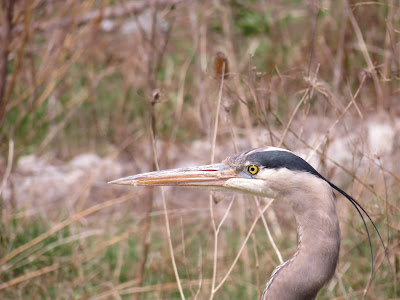During my time at Rondeau I took very few bird photos, and most of them were of rare, or at least uncommon, birds. What follows is some of those rarer birds, and the accompanying stories.
Yellow-headed Blackbirds are very rare in Southern Ontario, but small colonies occur on and off around Lake St. Clair. This year I finally decided to take the drive to see them, and while I missed the reported American White Pelicans, I was happy to see (and poorly photograph) several male blackbirds singing their bizarre song from the reeds.
Grasshopper Sparrow is a common breeding bird in parts of Ontario, but is generally quite hard to find in migration. As a result, I was quite pleased to find this individual feeding on the edge of a trail. Normally they stay low in dense grass and are nearly impossible to see.
Rondeau is probably the best place in Canada to see Prothonotary Warblers, and this was an excellent year for them. I saw at least six, including a female and the two males fighting over her that were incredibly reliable every day on Tulip Tree Trail. By the time I left, one male may have moved on but the remaining pair was regularly seen mating and nest building.
Females are much duller than the males (above)
The bird of the spring for Rondeau was this Kirtland's Warbler discovered on May 11. I was birding with Mike Irwin near the group campground when we found about it, and we raced over and saw it with five minutes to spare before it disappeared for good! Well, not quite for good, as it was seen by a few people at the same location on the evening of May 15th, somehow having eluded detection for the intervening time. I'm very lucky that I made it in time for the first sighting, as many local birders missed it entirely. Although Kirtland's is an annual sight at Point Pelee, it goes unrecorded most years at Rondeau, likely an artifact of the much lower birding effort.
Kirtland's Warbler is an incredibly rare bird on a global level, with only 2000 known singing males in 2012, and nesting restricted almost entirely to a small area of Michigan. Kirtland's require forest fires to create their nesting habitat and as a result have seriously declined.
American Avocet is a large and gorgeous shorebird from the prairies and southern United States. This bird showed up in the bizarre habitat of a flooded construction site on the outskirts of Leamington, Ontario, and was a lifer for me.
On the same day I had my lifer Avocet above at Pelee, I also saw my lifer Glossy Ibis there. As it turns out, I needn't have looked for it, as I found some myself just two days later!
I was leading a tour group around the Blenheim Sewage Lagoons, and we were just checking the final pond. I did a thorough scan, not noticing anything too unexpected, and then started putting the scope on each species to point them out.
An extremely late Tundra Swan has been spending its spring here, and as I got it in the scope I noticed an odd dark reddish bird sitting next to it on the bank. It was clearly an ibis! We watched it for 10 or 15 minutes, before suddenly somebody pointed out there were actually two birds present, both moving in and out of the vegetation.
It took a while but we eventually got good enough looks at the face to confirm Glossy Ibis rather than the almost identical White-faced. Not long after, the two birds flew off.
Glossy Ibis is a very rare bird in Ontario, but this spring has seen a large number of sightings, with at least five different sightings of one or two birds around Southern Ontario. You can see one ibis on top of the bank in the first shot below and two in the second. Also note the confused Tundra Swan.
More to come!





























